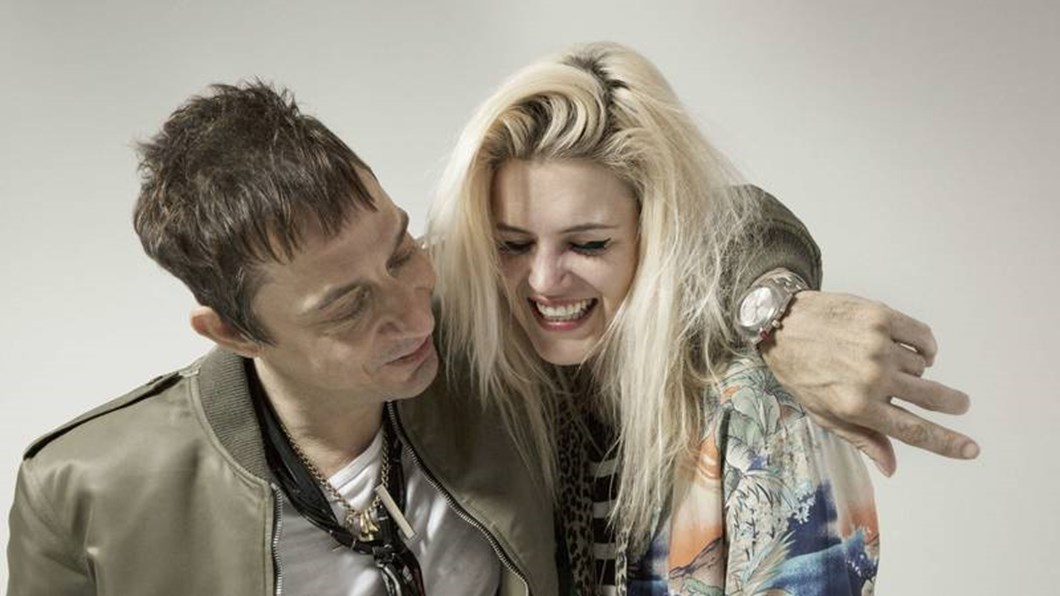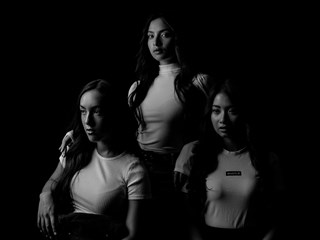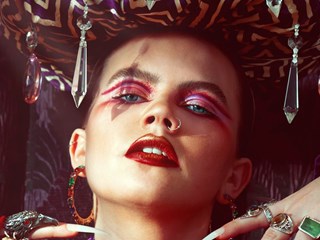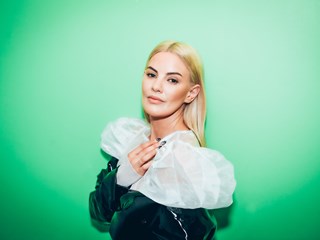With 15 years and five albums worth of songs under their belt, the Kills have no plans of slowing down. Following the June release of their much-anticipated new album Ash & Ice, bandmates Alison Mosshart and Jamie Hence returned to the road this summer for three-month's worth of concerts in North America and Europe.
Without losing their slow burning, bare-bones sound, Ash & Ice marks a new era for the Kills. In the five years since their last full-length, 2011's stellar Blood Pressures, plenty has changed for the duo. In 2013, a hand injury and subsequent surgery forced Hince to relearn the guitar. Meanwhile, Mosshart released a new album with The Dead Weather (2015's Dodge and Burn) and honed in on her painting, which she says has opened up a whole new world of creative expression. Her first solo show, Fire Power, took place last year in New York, and was made up mostly of works she'd painted while on tour.
Leading up to the band's recent shows in Los Angeles, we caught up with Mosshart to talk about Ash & Ice, The Dead Weather, painting, and how it all intersects on the road.
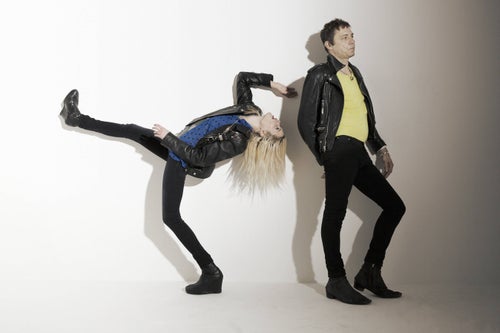
You and Jamie have been playing together for 15 years. What's the dynamic like when you're on the road?
It's like home, it's normal, you know? It's what we know, and I think it's really exciting. It's exciting to be playing this whole new record, and having this whole new batch of songs to play. And now five records to flip back and forth from.
How does touring with bands like The Dead Weather compare?
I don't know, you don't ever really think about that when you're touring with somebody It's been a long time since The Dead Weather have toured, so it's not the freshest thing on my mind. The Kills is such a great experience live because it's Jamie and I, and it's ultimately a duo no matter how many people we have behind us playing. With the drum machine and that kind of tightrope mentality, the live shows are definitely a different kind of energy. It's still crazy and wild, but it's got this added element that creates a kind of tension that's different. Having said that, being on tour with The Dead Weather is a different tension in that you don't know what's gonna happen. That band turns on a dime, starts playing something else, and then goes back—it can go a thousand different directions in an evening. It's a similar intensity, it's just different where it comes from.
What are some of your biggest learnings after touring for so long?
I just love it. Being on stage to me is the most natural environment I can put myself in. It's where I'm best, it's my favorite thing to do. I get everything from it. I'm always sad that it's over in an hour and a half, you know? [Laughs] But shit, but we gotta get somewhere else and we gotta do it again tomorrow. It's like this endless traveling circus, and it's totally nuts, but I love it. I didn't think I would be doing it all these years, and I really have been on tour since I was 14, so that's more than half my life, and I love it as much as I always did.
So it really is your home.
It is. The coolest thing is that it still happens. It shocks me all the time when we play places for the first time. It's really hard to find those places anymore, and when they happen it's extraordinarily exciting. Like, 'Wow, I've never been to this country or this city, I don't know what to expect.' You go to Paris and you played Paris like 75 times in your life, and New York and L.A and Chicago and Tokyo, and then all of a sudden you play somewhere you've never been and it's really thrilling. It's like Christmas day.
Have you had any of those experiences recently, where you fell in love with a new place?
I have, I have. I'm really shit at remembering names of things, but it's actually happened a ton of times this summer on tour at festivals and things. In Europe, there were a lot of places where I'd look at Jamie and be like, 'We've never been here, have we? No? Yes! Awesome!' We played Russia for the first time—we played Moscow, and we'd never played Moscow. I don't know if I ever thought we would get to. It's just one of those places where, when you're a kid or a teenager or whatever, you don't really think that that's gonna be on your touring schedule. But it was, and it was awesome. And the Ukraine, we played the Ukraine, we'd never done that before either. So, it was cool.
Can you tell me a bit about your art and how it plays a role in touring?
That's become something that I've done more and more of as I've gotten older. You start to realize you live in this bubble environment of airplane-hotel-backstage, where you need to be making something, you need to not turn your creative brain off during all of that. It's really easy to do because touring can be really tiring. When you're jet-lagged everything can get a little whacky, so it's nice to have that sort of centering point. There are always these weird hours during the day, usually after soundcheck and before doors, when there's a lot of people outside and you're sort of trapped in whatever basement, pit, bank window, and you can't really go for a wander. I love walking and I'll walk all over a town, but there's a certain time where you're like, 'I'm in for the night.' I also love that at the end of the show I'll go backstage and I'll have all these paintings that have dried while we played, and I'll pack 'em up in my suitcase and move on. It's a nice sense of accomplishment, even if they have no home or nowhere to go and I'm not painting for a show in particular.
I just had a show in Alabama last weekend for part of Billy Reid's Shindig, and I had a goal the last time we did an American tour to paint the whole thing. For about three and a half weeks I painted every day that I could on the road, and then that was a show. It's like a diary in a way, of all these places I've been. I hadn't seen them in a month and a half, or two months, and I saw them all up on the wall, and it was just like, rushing back to every single town, every single gig, every backstage, everything I did. It's not like anyone else can look them and know where I got coffee, or when I got lost, or what a fucking nightmare we had with the guestlist, or whatever it was. It doesn't matter, but it's all in there to me. It was really nice to see them all on a wall together as a complete body of work. I like to paint in chunks like that because it's like looking back on my own history, in a very colorful, bizarre way, without words.
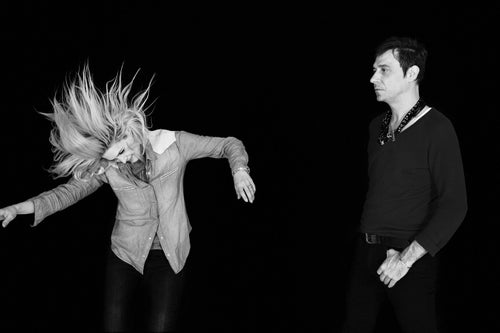
Your aesthetic as band has always been really strong. Can you talk a little bit about the art for the Ash & Ice?
It started with a Christmas present that I gave Jamie—I got him a leather-bound notebook, one with "Ash & Ice" written on it after we'd finished the record. It was beautiful, with this gold embossing on black leather, and he loved it so much he thought we should make the record look like the book. Then it became 'How can we represent the words with symbols, and make this make sense?' We tried a bunch of things. I was in L.A., and when it came down to it I only had three days to do all of the artwork. It was really nuts. I came up with that cover, and then we went to this guy's art studio in a garage in Eagle Rock. He had a photocopy machine and I had my paints and my scissors and my glue stick and I made this gigantic, huge square collage, which ended up being what's inside [the album]. The poster that folds out—it's all real. I have the master copies of them and they're exactly the same size. They're huge.
And the artwork plays into the video for "Under The Gun."
Yeah. The symbol became something to riff off of. One day after the record came out I saw on Instagram that someone had gotten a Kills tattoo. I started thinking it would be awesome to re-do the record cover in skin—like skin with tattoos of all the symbols. I don't think we'll ever do it, but that's where I got the idea for the film. I was really pleasantly surprised [by the experience of making "Under The Gun"]. That's a big ask, asking people to get a Kills tattoo for the rest of their life and you don't even get to choose what you get? [Laughs] That's a competition I don't know if I would enter. But thousands of people wanted to do it.
That had to be a crazy feeling.
Yeah! It was really exciting to go to this tattoo parlor I love, which is Mark Maloney's place, and watch this go down. We hung out with all these wonderful people, and our fans are so fucking cool and lovely. It was a really, really nice time.
How do you think the band's sound has changed since Blood Pressure?
I hope that we've become better songwriters. I hope that we've learned about music more. We worked really hard on the lyrics for this record. We worked on frequencies, we worked on drum beats, we worked on melodies. Every single aspect of this record we felt like we focused on more than we have in the past. You're always trying to push yourself and do better and makes something that makes you uncomfortable until you can actually play it well enough. It's far bigger than what you're capable of doing, and then you just work and work and make yourself capable.
What's next?
Well, we'll be touring for the rest of our lives I think, it's looking like that. [Laughs]
As you said, you love it.
I also love to sleep, though. [Laughs] But we're gonna tour til mid- to late November, and then we'll probably pick back up again in mid-January or the beginning of February. There's still, like I said, a million places we haven't been. It'll be exciting, I'm looking forward to it.

